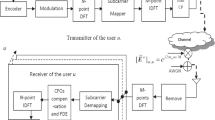Abstract
Unitary space-time modulation (USTM) fits for rapid Rayleigh flat fading channels as it can realize wireless communication when neither the transmitter nor the receiver knows the channel state information (CSI). However, an intrinsic problem is that only when the signal-to-noise ratio (SNR) is high can it give an ideal bit error rate (BER) performance. The existing bit-wise processing scheme of the combination of turbo code and USTM improves the BER performance and results in an unacceptable calculation complexity, storage and time delay problem. In this paper, we propose a multiary processing scheme and its corresponding multiary MAP decoding algorithm. Simulation results verify that our scheme can reduce the system complexity while keep a good BER performance. Furthermore, we present the first analysis of the reason for the BER performance deterioration of the combination scheme at low SNR with the help of the definition of USTM.
Similar content being viewed by others
References
Telatar I E. Capacity of multi-antenna Gaussian channels. Technical Report, AT&T Bell Labs, 1995
Foschini G J, Gans M J. On limits of wireless communication fading environment when using multiple antennas. Wireless Personal Commun, 1998, 6: 311–335
Tarokh V, Seshadri N, Calderbank A R. Space-time codes for high data rate wireless communication: performance criterion and code construction. IEEE Trans Inf Theory, 1998, 44: 744–765
Alamouti S M. A simple transmit diversity technique for wireless communications. IEEE J Select Areas Commun, 1998, 16: 1451–1458
Tarokh V, Jafarkhani H, Calderbank A R. Space-time block coding for wireless communication: performance results. IEEE J Select Areas Commun, 1999, 17: 451–460
Jafarkhani H, Tarokh V. Multiple transmit antenna differential detection from generalized orthogonal designs. IEEE Trans Inf Theory, 2001, 47: 2626–2631
Foschini G J. Layered space-time architecture for wireless communication in a fading environment when using multiple antennas. Bell Lab Tech J, 1996, 1: 41–59
FRAMES Multiple access proposal for the UMTS radio interface-SMG2, Dec. 1996, Workshop on UMTS Radio Interface Technologies
Marzetta T L, Hochwald B M. Capacity of a mobile multiple-antenna communication link in Rayleigh flat fading. IEEE Trans Inf Theory, 1999, 45: 139–157
Hochwald B M, Marzetta T L. Unitary space-time modulation for multiple-antenna communications in Rayleigh flat fading. IEEE Trans Inf Theory, 2000, 46: 543–564
Zhang D P, Liu J, Xu H J, et al. Pair-wise error probability and its Chernoff upper bound for unitary space-time code. Sci China Inf Sci, 2010, 53: 1613–1621
Berrou C, Glavieux A, Thitimajshima P. Near Shannon limit error-correcting coding and decoding: Turbo-codes. In: IEEE Int Conf on Communications 1993 (ICC’93), Geneva, Switzerland, 1993. 1064–1070
Jayaweera S K, Poor H V. Turbo (iterative) decoding of a unitary space-time code with a convolutional code. In: Vehicular Technology Conference (VTC Spring 2002), Birmingham, USA, 2002. 1020–1024
Bahceci I, Duman T M. Combined turbo coding and unitary space-time modulation. IEEE Trans Commun, 2002, 50: 1244–1249
Wang J, Zhao Y, Fan S. Turbo trellis-coded unitary space-time modulation for non-coherent multiple-antenna Rayleigh fading channel. In: Proc. IEEE International Conference on Wireless Communications, Networking and Mobile Computing (WiCom’2007), Shanghai, China, 2007. 72–76
Zheng L, Tse D N C. Communication on the Grassmann manifold: A geometric approach to the noncoherent multipleantenna channel. IEEE Trans Inf Theory, 2002, 48: 359–383
Hochwald B M, Marzetta T L, Richardson T J, et al. Systematic design of unitary space-time constellations. IEEE Trans Inf Theory, 2000, 46: 1962–1973
Hochwald B M, Sweldens W. Differential unitary space-time modulation. IEEE Trans Commun, 2000, 48: 2041–2052
Panagos A, Kosbar K. A new design metric for unitary space-time codes. In: Int. Conf. on Wireless Communications and Mobile Computing 2006 (IWCMC’06), Vancouver, British Columbia, Canada, 2006. 671–675
Bingeman M, Khandani A K. Symbol-based Turbo codes. IEEE Commun Lett, 1999, 3: 285–287
Bahl L, Cocke J, Jelinek F, Raviv J. Optimal decoding of linear codes for minimizing symbol error rate. IEEE Trans Inf Theory, 1974, 20: 284–287
Zhang D P, Liu J, Ji H. A simple size-reduced constellation scheme for unitary space-time modulation. In: IEEE Int. Conf. on Communication Systems 2008 (ICCS’08), Beijing, China, 2008. 87–91
Author information
Authors and Affiliations
Corresponding author
Rights and permissions
About this article
Cite this article
Zhang, D., Lu, J., Xu, H. et al. Multiary turbo code fitting for unitary space-time modulation and its MAP decoding algorithm. Sci. China Inf. Sci. 53, 2610–2619 (2010). https://doi.org/10.1007/s11432-010-4111-9
Received:
Accepted:
Published:
Issue Date:
DOI: https://doi.org/10.1007/s11432-010-4111-9




